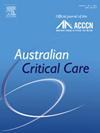The effectiveness of a three-dimensional printed model for training novice healthcare professionals in central venous catheter insertion: A cross-sectional study in a critical care setting
IF 2.6
3区 医学
Q2 CRITICAL CARE MEDICINE
引用次数: 0
Abstract
Background
We have previously used three-dimensional printing to develop a novel manikin for simulation training of central venous catheter insertion in critical care. The objective of this study was to evaluate the fidelity of the model by testing with novice and experienced operators.
Methods
A convenience sample of intensivist physicians experienced in central venous catheter insertion and critical care nurses without prior central venous catheter training was assembled. Participants were offered a video educational clip and a one-on-one demonstration. All participants were then asked to insert a central venous catheter into the model. Outcomes included requests for assistance, success rate, time to insertion, and subjective feedback.
Results
Thirteen intensivists and 14 nurses participated. Nurses were more likely to view the demonstration video prior to the procedure (13/14; 92.9% vs. 7/13; 53.9%; p = 0.033). Intensivists were more likely male (11/13; 84.6% vs. 3/14; 21.4%; p = 0.002) and tended to be older, with a higher proportion in the 35- to 44-year and 45- to 54-year age ranges than the nurses (92.3% vs. 71.4%; p = 0.426). Nurses requested more assistance and received more guidance but had similar overall success (100.0% vs 92.3%; p = 0.481). The median time taken for the procedure was 19 min and 59 s for nurses and 8 min and 14 s for intensivists (p = 0.004). All participants agreed that the model effectively prepared trainees for their first human central venous catheter insertion. Nurses also reported a significant increase in procedural confidence post simulation. Additionally, most participants agreed or strongly agreed that the model realistically simulated the femoral vein, an essential aspect of the central venous catheter insertion.
Conclusions
Nurses required additional assistance and took longer to complete the insertion, demonstrating preliminary evidence for the model's construct validity. Furthermore, the model was deemed a realistic training tool with successful insertion by nearly all participants.
三维打印模型用于培训新手医疗保健专业人员中心静脉导管插入的有效性:一项在重症监护环境下的横断面研究
我们之前已经使用三维打印技术开发了一种新的人体模型,用于模拟重症监护中心静脉导管插入的训练。本研究的目的是通过对新手和有经验的操作员进行测试来评估模型的保真度。方法选取有中心静脉置管经验的重症医师和未接受过中心静脉置管培训的重症监护护士作为方便样本。参与者被提供了一个视频教育剪辑和一对一的示范。然后要求所有参与者在模型中插入中心静脉导管。结果包括请求协助、成功率、插入时间和主观反馈。结果共有重症医师13名,护士14名。护士更有可能在手术前观看演示视频(13/14;92.9% vs. 7/13;53.9%;p = 0.033)。重症医师中男性居多(11/13;84.6% vs. 3/14;21.4%;P = 0.002),且年龄倾向较大,其中35 ~ 44岁和45 ~ 54岁的比例高于护士(92.3% vs. 71.4%;p = 0.426)。护士要求更多的帮助和接受更多的指导,但总体成功率相似(100.0% vs 92.3%;p = 0.481)。护理人员的中位手术时间为19分钟59秒,重症监护人员为8分钟14秒(p = 0.004)。所有参与者都同意,该模型有效地为受训人员的第一次人体中心静脉导管插入做好了准备。护士们也报告了模拟后程序信心的显著增加。此外,大多数参与者同意或强烈同意该模型真实地模拟了股静脉,这是中心静脉导管插入的一个重要方面。结论护士需要额外的帮助,并且需要更长的时间来完成插入,为模型的结构效度提供了初步证据。此外,该模型被认为是一个现实的培训工具,几乎所有参与者都成功地插入。
本文章由计算机程序翻译,如有差异,请以英文原文为准。
求助全文
约1分钟内获得全文
求助全文
来源期刊

Australian Critical Care
NURSING-NURSING
CiteScore
4.90
自引率
9.10%
发文量
148
审稿时长
>12 weeks
期刊介绍:
Australian Critical Care is the official journal of the Australian College of Critical Care Nurses (ACCCN). It is a bi-monthly peer-reviewed journal, providing clinically relevant research, reviews and articles of interest to the critical care community. Australian Critical Care publishes peer-reviewed scholarly papers that report research findings, research-based reviews, discussion papers and commentaries which are of interest to an international readership of critical care practitioners, educators, administrators and researchers. Interprofessional articles are welcomed.
 求助内容:
求助内容: 应助结果提醒方式:
应助结果提醒方式:


